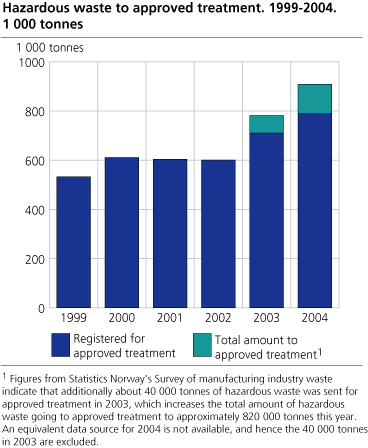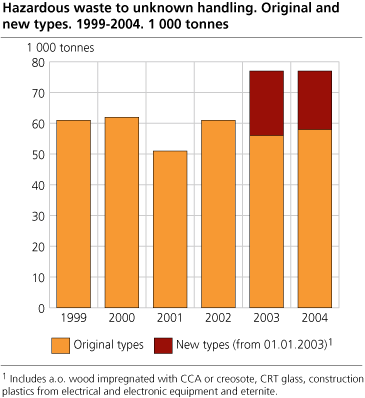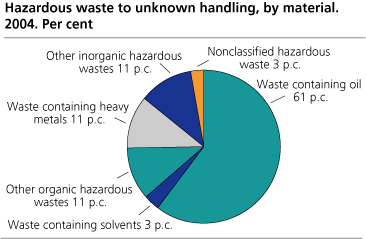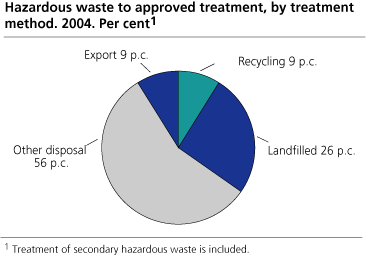Content
Published:
This is an archived release.
Close to 1 million tonnes in a year
We got rid of almost 1 million tonnes of hazardous waste in 2004, giving a rise of as much as 14 per cent from the year before. The major part of the waste was treated by environmentally sound methods. Still 80 000 tonnes cannot be properly accounted for, and parts may in a worst case have been spread to the nature.
A total of 908 000 tonnes of hazardous waste from Norwegian industry and households went to approved treatment in 2004, an increase by 126 000 tonnes from 2003. Norwegian facilities treated 828 000 tonnes, excluding 11 000 tonnes of secondary hazardous waste. Furthermore, 81 000 tonnes were exported.
Significant rise in approved treatment
The amount of hazardous waste recorded in the administrative registers for approved treatment has risen by as much as 48 per cent from 1999 to 2004. A small part of the increase is due to several new types of waste been defined as hazardous waste from 1/1-2003. However, we believe that the major part of the increase is a real rise in waste amounts. A third explanation might be a potential increase in the effectiveness of recording waste in the administrative registers during these six years. The effect of this cannot be told due to lack of data.
The total amount of hazardous waste treated as approved in 2004 is likely to be somewhat higher than 908 000 tonnes for at least two reasons. Firstly, water is removed from oil-containing hazardous waste during temporary storage pending the treatment. Secondly, unpublished results from Statistics Norway's survey of manufacturing industry waste in 2003 indicate that a substantial amount of corrosive waste is found in neither of the two other sources and should be added to the total amount. Hazardous waste not entering approved treatment comes in addition to this. Therefore, the total amount of hazardous waste in 2004 is found likely to be between 950 000 and 1 000 000 tonnes.
Waste containing heavy metals (mostly slag), corrosive waste and oil-containing waste are the dominating waste types, and the former two primarily originates from the manufacturing industry. This is the situation since 1999. 85 000 tonnes of the oil-containing waste came from oil drilling, while 70 000 tonnes came from service activities.
New types increased amounts to unknown treatment
77 000 tonnes of hazardous waste was treated in unknown ways in 2004. This is on level with the year before, but 26 per cent more than in 1999. The increase is mainly due to the inclusion of new types hazardous waste from 1/1-2003. Unknown handling covers both unrecorded but approved treatment and illegal handling. Our new figures indicate that a substantial part has entered approved treatment.
Oil-containing waste is the predominant waste being handled in unknown ways, as was the situation in 1999. However, Statistics Norway's new survey indicates that this waste type in particular is underreported in the registers.
The amount of PCB-containing waste and impregnated wood waste treated in unknown ways is lower than shown by previous estimations, due to changes in calculation method. Our latest figures show amounts of 300 and 6 000 tonnes respectively.
More than 80 per cent to final treatment or disposal
More than 80 per cent of all hazardous waste entering approved treatment is either landfilled at specially engineered sites or disposed of in other ways. A great fraction of this waste is stabilised and used for restoring of a land area.
Of the waste being material or energy recovered, near 80 per cent is waste oil and minor amounts of other waste types incinerated for the energy. Some oil-containing and corrosive waste is recycled and a small amount goes to biological treatment.
Export of hazardous waste applies to waste with heavy metals and contaminated processing water for the most part. The two waste types cover 40 and 30 per cent of the export respectively, followed by corrosive waste and oil-containing waste. Waste is exported for recycling or for disposal operations not offered in Norway only.
Evaluation of the source data
The figures are based on compiling and calculations of administrative registers and two new surveys. Previously, the administrative registers were our main data source. However, the surveys clearly indicate that a significant amount of hazardous waste handed in for approved treatment, was never reported to the administrative registers. In 2004 this underreporting has been estimated to approximately 120 000 to 150 000 tonnes. However, for some waste types the registers show the bigger amount. This may be due to storage fluctuations at the treatment facilities or misclassifications. It may also indicate underreporting to the treatment survey, suggesting that also this survey slightly underestimates the amount of hazardous waste entering approved treatment. The manufacturing waste survey supports this conclusion, at least for corrosive waste.
Tables:
- Table 1 Hazardous waste registered for approved treatment 1999-2004 and total amount treated as approved 2003 and 2004. 1 000 tonnes
- Table 2 Hazardous waste treated as approved, by material. 2004. 1 000 tonnes
- Table 3 Hazardous waste to unknown handling. Original and new types. 1999-2004. 1 000 tonnes
- Table 4 Hazardous waste to unknown handling, by material. 2004. 1 000 tonnes
- Table 5 Hazardous waste treated as approved, by method of treatment. 2004. 1 000 tonnes
- Table 6 Hazardous waste treated as approved, by industry. 2004. 1 000 tonnes
Additional information
Approved treatment as applied in this article includes only hazardous waste generated in Norway (export is therefore included, while import is excluded).
Contact
-
Gisle Berge
E-mail: gisle.berge@ssb.no
tel.: (+47) 48 12 19 97
-
Terje Lorentzen Landsem
E-mail: terje.landsem@ssb.no
tel.: (+47) 98 84 31 39





